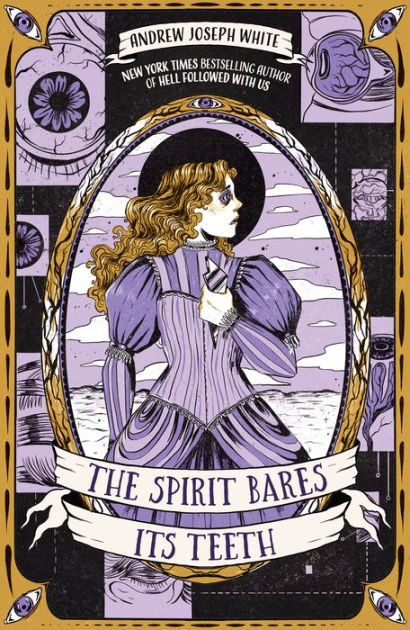I feel like it bears mentioning that I first read Andrew Joseph White’s The Spirit Bares Its Teeth immediately following the completion of a queer horror fiction course I taught at university. So, I came to this book with all of the tropes, criticisms, and “perverse” forms of rebellion swirling in my head.
Truth be told, I think that made me love this book even more.
Before we dig in, though, for those of you who are unfamiliar, here is a blurb of the story as per the publisher’s (Peachtree Publishing’s) site:

“Mors vincit omnia. Death conquers all.
London, 1883. The Veil between the living and dead has thinned. Violet-eyed mediums commune with spirits under the watchful eye of the Royal Speaker Society, and sixteen-year-old Silas Bell would rather rip out his violet eyes than become an obedient Speaker wife. According to Mother, he’ll be married by the end of the year. It doesn’t matter that he’s needed a decade of tutors to hide his autism; that he practices surgery on slaughtered pigs; that he is a boy, not the girl the world insists on seeing.
After a failed attempt to escape an arranged marriage, Silas is diagnosed with Veil sickness—a mysterious disease sending violet-eyed women into madness—and shipped away to Braxton’s Finishing School and Sanitorium. The facility is cold, the instructors merciless, and the students either bloom into eligible wives or disappear. When the ghosts of missing students start begging Silas for help, he decides to reach into Braxton’s innards and expose its guts to the world—if the school doesn’t break him first.
Featuring an autistic trans protagonist in a historical setting, Andrew Joseph White’s much-anticipated sophomore novel does not back down from exposing the violence of the patriarchy and the harm inflicted on trans youth who are forced into conformity.”
In my opinion, the key to successful, critical, and intriguing horror fiction is the author’s ability to use traditional “scare tactics” to show the reader that what they’ve been told is grotesque and horrifying is not the root of what they should truly be afraid of. White does this masterfully.
Between the vivid moments of gore and the constant interweaving of the lands of the living and the dead, there are countless moments of traditionally “gross” and “creepy” things within this book. But those aren’t what should scare us.
What should horrify us is the treatment of the main character, Silas, and the other “othered” characters he meets along his journey. The rampant and truly life-threatening transphobia, misogyny, ableism, and mistreatment of any and all characters who do not fit within the perfect box society has set forth—that is the horror underlying this novel and that makes the thought of ripping out your own eyes feel tame.
Andrew Joseph White gives us that horror—he gives us every layer of horror—in this novel in a way that manages to be somewhat gentle to the reader (a choice I imagine is tied to the YA audience this book has) without shying away from being truthful within the context of the world he’s built.
Regardless of if the audience was the driving reason behind these choices, I do think any reader will appreciate the sense of community and the feelings of “home” that White does eventually allow Silas to find. Though narrative style of the novel can make the reader feel insulated and alone—as Silas himself often feels—the broader picture drives home that finding and building a community is one way to endure the horrors of the world.
Speaking of community, I do admit there was one point in the novel that did give me pause. I can’t talk about it too much without giving away an element of the ending, but to be brief, I did feel like the other students that Silas meets at Braxton occasionally feel more like plot devices than characters with their own agency. Now, we could dig into the idea of agency, specifically as it relates to the position of students/patients but I think that would be a bit outside of the scope of this review. Instead, I’ll just say that there was really only one instance/character that gave me pause in this regard but, that aside, I think White handled each character and the relationships built between them exceptionally well.
Though this is not an element of the novel’s plot/story, I will say that I did appreciate the addition of the historical note at the end of the book. In this note, White points the reader towards other sources on real life historical events that impacted other marginalized communities in unspeakably horrific ways. This note is needed, and appreciated, as the horrors that he refers to are neither new nor so far past that their pain is not felt still today.
Overall, White’s The Spirit Bares Its Teeth is a vivid and horrifying portrayal of real life horrors interwoven with a sort of spectral fantasy. But rest assured, even when the bleeding makes the wound too difficult to see, White and his characters will be there to apply pressure, staunch the flow, and make sure everything is sewn up tight—with a running stitch, of course.
For more information about The Spirit Bares Its Teeth, head on over to Peachtree Publishing where you can also find links to everywhere the novel is sold!